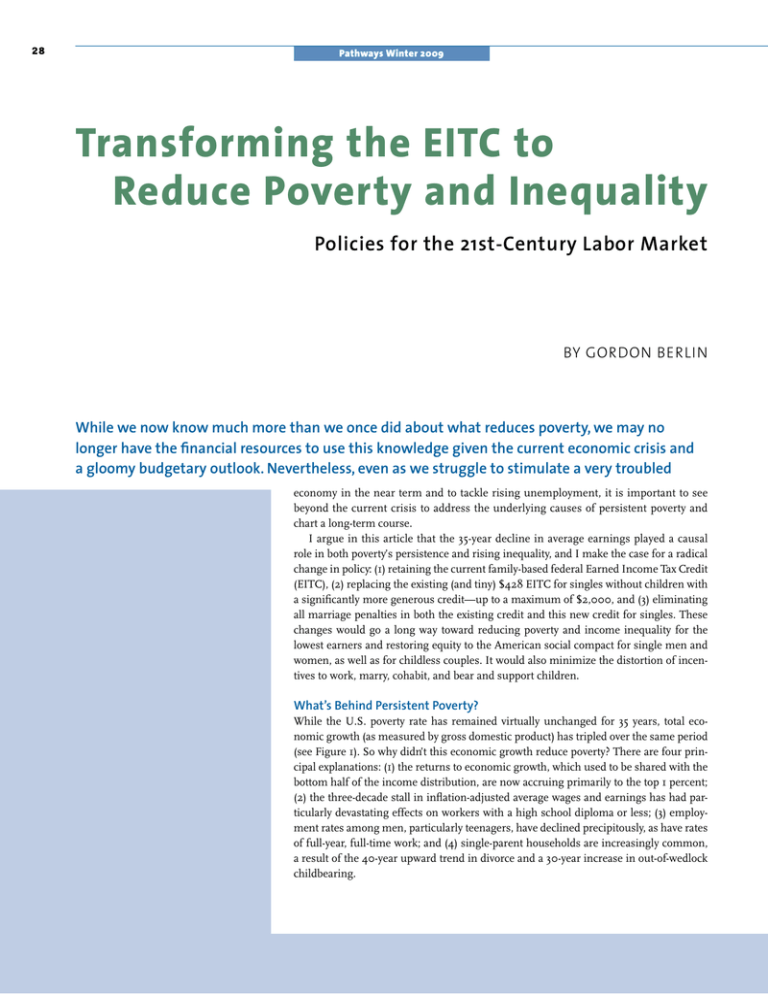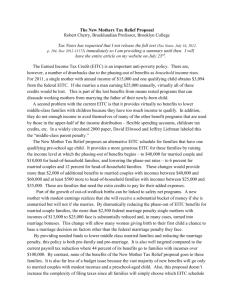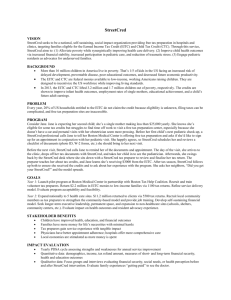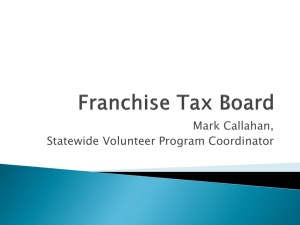Transforming the EITC to Reduce Poverty and Inequality
advertisement

28 Pathways Winter 2009 Transforming the EITC to Reduce Poverty and Inequality Policies for the 21st-Century Labor Market By Gordon Berlin While we now know much more than we once did about what reduces poverty, we may no longer have the financial resources to use this knowledge given the current economic crisis and a gloomy budgetary outlook. Nevertheless, even as we struggle to stimulate a very troubled economy in the near term and to tackle rising unemployment, it is important to see beyond the current crisis to address the underlying causes of persistent poverty and chart a long-term course. I argue in this article that the 35-year decline in average earnings played a causal role in both poverty’s persistence and rising inequality, and I make the case for a radical change in policy: (1) retaining the current family-based federal Earned Income Tax Credit (EITC), (2) replacing the existing (and tiny) $428 EITC for singles without children with a significantly more generous credit—up to a maximum of $2,000, and (3) eliminating all marriage penalties in both the existing credit and this new credit for singles. These changes would go a long way toward reducing poverty and income inequality for the lowest earners and restoring equity to the American social compact for single men and women, as well as for childless couples. It would also minimize the distortion of incentives to work, marry, cohabit, and bear and support children. What’s Behind Persistent Poverty? While the U.S. poverty rate has remained virtually unchanged for 35 years, total economic growth (as measured by gross domestic product) has tripled over the same period (see Figure 1). So why didn’t this economic growth reduce poverty? There are four principal explanations: (1) the returns to economic growth, which used to be shared with the bottom half of the income distribution, are now accruing primarily to the top 1 percent; (2) the three-decade stall in inflation-adjusted average wages and earnings has had particularly devastating effects on workers with a high school diploma or less; (3) employment rates among men, particularly teenagers, have declined precipitously, as have rates of full-year, full-time work; and (4) single-parent households are increasingly common, a result of the 40-year upward trend in divorce and a 30-year increase in out-of-wedlock childbearing. Intervention Reversing the long-term secular decline in earnings is key to addressing the nation’s persistent poverty problem. From 1947 to 1973, real average earnings grew steadily at 2 to 3 percent per year. In this period, economic growth benefited those at the bottom of the income distribution; today those benefits accrue entirely to the top 1 percent. Why? Globalization and technological change placed a new premium on higher education (particularly in the 1980s and 1990s), while immigration placed new pressure on wages at the bottom of the earnings distribution. As economists Frank Levy and Peter Temin have described, these macroeconomic forces were exacerbated by the decline in unions, in the minimum wage, in tax rates on the wealthy, and in norms governing CEO pay—institutional structures that had helped lowwage workers in the mid-20th century. A new set of 21st-century labor market institutions have yet to replace and reconfigure these currently moribund institutions and polices. The persistence of stagnant earnings has a cascading effect on a cluster of poverty-related problems. The interactions between low earnings, reduced employment, increased incarceration, and nonmarital childbearing have created a tangled web of reinforcing social conditions. For example, low earnings and single parenthood interact to exacerbate poverty and inequality. Single-parent families are more likely to be poor than two-parent families—five times more likely—in part because these families are more likely to have low education levels and command low wages, and in part because they have only one earner when most two-parent families have two. What Is the Best Fix? To make progress against poverty and inequality in America, we must do something about stagnating and falling earnings— that is, we must once again make work pay for the bottom half of workers. This is exactly what we have begun to do with the Earned Income Tax Credit (EITC)—by far the nation’s largest antipoverty program, accounting for $47 billion a year in federal expenditures. Conditioned on work, the EITC is a safety net built around employment—only people with earnings from gainful employment can claim the credit. The value of the EITC varies by both family type and annual earnings. Families with two or more children can receive a maximum annual credit of $4,716; those with one child, $2,853; and single adults with no children, $428. The credit therefore virtually ignores an entire class of workers: those who are not supporting children. The U.S. social welfare system was designed almost exclusively to meet the needs of poor families with children, a majority of whom are now femaleheaded, single-parent households. Outside of food stamps, few work supports are available for childless individuals; indeed, the only public systems that focus predominantly on able-bodied men who are not living with children are criminal justice and child support enforcement. Adding insult to injury, by treating income jointly, the tax system penalizes some couples when they do marry, especially couples who earn like amounts and have combined annual earnings between $20,000 and $30,000. As they begin to lose eligibility for food stamps and health benefits, such as Medicaid and the State Children’s Health Insurance Pro- 29 30 Pathways Winter 2009 gram, and cross over to the phase-down range of the EITC, they can lose as much as a dollar in benefits for every dollar increase in income. In a vicious cycle, once they are married, the same high cumulative marginal tax rates penalize additional work effort, a clear deterrent to work by the second earner. An unintended consequence of this policy choice is a distortion of incentives to work, marry, cohabit, and bear and support children. Do Earnings Supplements, Like the EITC, Work? A strong and reliable body of evidence indicates that earnings supplements, like the EITC, do much good. Nonexperimental evidence suggests that the EITC increases work, increases income, reduces family poverty by a tenth, and reduces poverty among children by a fourth. Remember that the Census Bureau’s official poverty estimate doesn’t count the EITC as income; if it did—and if one also subtracted the cost of work expenses, child care, and payroll taxes—the poverty rate would likely fall by a couple of percentage points. This research is buttressed by re­s ults from the “make work pay” experiments. Concerned that low-wage work simply did not pay relative to welfare, the state of Minnesota, the New Hope community group in Milwaukee, and two provinces in Canada began testing new approaches to increase the payoff from low-wage work in the 1990s—that is, to make work pay. All three combined workconditioned incentives in the form of monthly cash payments to supplement the earnings of low-wage workers. The payments were made only when people worked, and the amount of each month’s cash payment depended on the amount of each month’s earnings. The mostly single mothers who were offered earnings supplements in these three large-scale, rigorous studies were more likely to work, brought home more earnings and income, and were less likely to be in poverty than control group members who were not offered supplements. At their peak, these employment, earnings, and income gains were large—reaching 12 to 14 percentage point increases in employment rates, $200 to $300 more in quarterly earnings, and $300 to $500 more in quarterly income. While overall earnings effects dissipated over time, large and persistent effects were found for African-Americans and for the most disadvantaged participants, particularly high school dropouts without a recent work history and with long welfare spells. Unexpectedly, parents’ employment and income gains produced, in turn, modest but important improvements for their younger school age children in a range of school measures, including standardized test scores. An Enhanced EITC for Singles and Second-Earners, with a Radical Twist in Tax Policy If the evidence suggests, then, that an expanded EITC could further reduce poverty and inequality, how might we undertake such an expansion? There are many relevant proposals. These include enhancing the generosity of the basic family-based EITC benefit, increasing it for married couples only, boosting it for large families (currently, a two-child family receives the same benefit as a family with more children), and expanding the benefit for noncustodial parents when they pay child support. While each of these plans would reduce poverty, they have the disadvantage of perpetuating or exacerbating current inequities. In the remainder of this article, I outline a bold plan to revamp the EITC for the 21st-century labor market—establishing a new EITC for singles and second-earners. It has the virtue of being simple to understand, generous enough to stimulate a behavioral response, neutral (with regard to incentives to work, marry, and care for children), and equitable by reducing inequalities between adults with children and those not raising children—four criteria any EITC expansion plan should be judged against. This plan to transform the nation’s work-based safety net would (1) retain the current family-based EITC, (2) replace the existing $428 EITC for singles without children with a significantly more generous credit—up to a maximum credit amount of $2,000, and (3) eliminate all marriage penalties in both the existing credit and this new credit for singles by basing eligibility on individual rather than joint income. The enhanced EITC would make work pay for singles without children and for second-earners in two-parent families currently receiving the existing family-based EITC. In the latter families, the primary earner would continue to qualify for the child-based EITC, with the actual benefit amount based on his or her individual earnings. But now the second earner would qualify for a separate credit for singles. Such a change seems radical at first blush, considering the way the United States treats income for tax purposes. In Canada and some European countries, however, taxes are based on individual rather than family income, so there is precedent and experience on which to base operational details. Consider Jack and Jill. Jack works full time (2,000 hours per year) at $7.25 an hour—earning $14,500 a year. His income exceeds the $12,590 eligibility for the current EITC credit for singles. However, under the new singles benefit, he would receive an EITC refund check from the IRS totaling $2,000, or a 14 percent increase in his income. In other words, his $7.25-an-hour job now pays $8.25 an hour. Jill works for the same company, holds a similar job, and receives the same pay—$14,500 a year. The impact on poverty of this enhanced EITC would be certain, large, and immediate. 31 Intervention As a single parent with two children, she qualifies for the existing family-based EITC and, at the end of the year, receives a tax refund payment of $4,710, bringing her total annual income to $19,210. With the help of the EITC, Jill’s $7.25-an-hour job now pays $9.60 an hour. Assume for a moment that Jack and Jill head up the hill to fetch a marriage license. Under current law, their joint income would equal $29,000, and Jill’s EITC refund payment would fall to $2,260, a marriage penalty of $2,450. Now consider their life together in a world where singles qualified for a more generous credit and where both the singles credit and the family credit were based on individual income, not joint income—a world without marriage penalties. Jack would receive a singles credit of $2,000 and Jill the existing family credit of $4,710, for a combined amount of $6,710 and a total family income of $35,710.1 To avoid unintended consequences, policymakers should consider taking three additional, complementary actions. First, because the EITC is adjusted for inflation, it might be wise to also index the minimum wage to inflation, to avoid substituting future EITC increases for private wage increases. Second, to limit the likelihood that current full-time workers might reduce their work effort, and to encourage the unemployed or underemployed to work full time, one could limit the new singles supplement to people who work an average of at least 30 hours a week. Third, to avoid windfalls to otherwise well-off families, an arbitrary eligibility cap might be imposed on families with joint income that exceeded $65,000. But Would It Actually Work? The impact on poverty of this enhanced EITC would be certain, large, and immediate. Individuals who now work more than 30 hours a week (assuming a full-time work requirement) and earn less than the threshold amount annually (whether married, cohabiting, or unattached) would receive an immediate supplement. This supplement would help restore their earnings toward pre-1973 levels, when the average high school graduate—or even high school dropout—could support a family above the poverty line. Those working less than 30 hours a week, including second-earners in two-parent households, would have an incentive to increase their work hours, further boosting income, promoting self-sufficiency, and reducing poverty. Finally, those not in the labor force would have added incentive to find a full-time job, even if it offers low pay. Reliable experimental evidence indicates that revamping the EITC in this way would yield substantial employment gains. Economists estimate that increasing the hourly wage of lowincome workers by 10 percent would boost employment between 2 and 10 percent. Adding credence to these estimates, the three “make work pay” experiments described above had similar employment, earnings, and income effects, albeit for a population of mostly single mothers. Less reliable observational evidence suggests that an enhanced figure 1. Trends in Earnings, Poverty, and GDP 1947–2004 GDP (Dollar Index, 1947 = 100) Weekly Earnings of Production Workers (2004 $) Poverty Rate 700 35% 500 25% 300 15% 5% 100 1947 1952 1957 1962 1967 1972 1977 1982 1987 1992 1997 2002 Earnings Poverty GDP Sources: Bureau of Labor Statistics, U.S. Census Bureau, U.S. Dept of Commerce. Note: The Gross Domestic Product is represented as an index in which its 1947 value is $100 — the line shows that the GDP grew sevenfold between 1947 and 2004 (after taking inflation into account). EITC could also have small but significant beneficial effects on crime and marriage. As earnings rise, so do the opportunity costs of engaging in crime, meaning that men’s involvement in criminal activity might reasonably be expected to decline. Similarly, higher earnings, together with the elimination of EITC-related tax-and-transfer penalties on marriage, might also lead to more coparenting, cohabitation, and marriage. Although these secondary effects are speculative, an individually-based EITC benefit at least creates the necessary, if not sufficient, conditions to make an increase in marriage feasible. Finally, by supplementing the earnings of single men in lowwage jobs and increasing income, this plan encourages more “on the books” work, which would help men meet their child support obligations. As with current law, singles who are parents and owe child support would receive their EITC payment contingent on paying their child support obligations. Would It Be Worth the Cost? A generous EITC for singles without marriage penalties would cost roughly $33 billion a year. To put that number in perspective, this represents about a third of the annual tax reduction received by the top 1 percent of tax filers as a result of the Jobs and Growth Tax Relief Reconciliation Act of 2003. It is also equal to about 4 percent of the extra $750 billion in annual income that Steven 32 Pathways Winter 2009 Pearlstein of the Washington Post estimated now accrues to the top 10 percent of earners as a result of changes in the income distribution since the early 1970s. In return for this investment, poverty among singles and two-parent households would surely decline. And, as noted above, it is also possible we might see salutary secondary effects of increased employment, reduced crime, and rising marriage and cohabitation rates. In some cases, these secondary effects could generate state and federal savings, most notably in the form of reduced incarceration costs. Encouragingly, policy consensus is growing around the need to raise men’s earnings, and a bevy of experts and political leaders support increasing the EITC for singles as a mechanism: New York City Mayor Michael Bloomberg; Congressman Charles Rangel, chair of the powerful House Ways and Means Committee; neo-conservatives like Ross Douthat and Reihan Salam; major think tanks, including the Progressive Policy Institute and the Center for American Progress; and leading academics, including Harry Holzer, former chief economist at the Department of Labor, John Karl Scholz at the University of Wisconsin, and Gene Steuerle of the Peter G. Peterson Foundation. In the current environment of economic and budget crises, a generous expansion of the EITC for singles, coupled with elimination of marriage penalties, may not be regarded as feasible. However, insofar as deficit-expanding stimulus is to be undertaken, there are good reasons to make an enhanced EITC part of that stimulus, providing an opportunity to test the effects of a more generous singles EITC than might otherwise be possible. By delivering extra income to the bottom of the income distribution, the increased EITC would direct stimulus toward that subpopulation that is most likely to spend it, thereby increas- ing the multiplier effect, while also yielding crucial evidence to guide future policymaking in this area. To be effective stimulus, however, an expanded EITC should be paid quarterly rather than annually, as is the case now. At minimum, a prudent next step is to proceed incrementally—for instance, increasing the existing single credit modestly, as Congressman Rangel has proposed, and reducing marriage penalties somewhat—while mounting a rigorous demonstration and evaluation of a more generous program in one or two locations, perhaps with stimulus funding. Key questions the demonstration could answer include: What is the take-up rate for this revamped EITC? Does the offer draw people who are not working into the labor market? Does it reduce job-leaving? Do full-time workers cut back their work effort? How does it help two-parent families? What impact does it have on men versus women? What impact does it have on marriage and child-bearing? What is the effect on criminal involvement? If a fundamental revamping of EITC isn’t feasible now, a scaled-back approach of this sort allows us to move forward with our historic experiment in “making work pay”—because any serious effort to address income inequality and poverty will have to tackle nearly four decades of stagnant and falling wages, particularly for single men. An enhanced EITC for individuals without marriage penalties would effectively end poverty today for individuals and families who are able to work full time, while minimizing the distortions in incentives to work, coparent, and marry that exacerbate poverty and its persistence. An enhanced EITC for individuals without marriage penalties would effectively end poverty today for individuals and families who are able to work full time. . . Gordon Berlin is the President of MDRC. notes 1. How would the credit for singles and second-earners work? In “EITC speak,” every dollar in earnings would be supplemented by 25 cents until total annual earnings reached $7,800 and a maximum credit amount of nearly $2,000. At that point, the supplement would remain level until earnings reached nearly $14,500, when it would then fall to 16 cents for every additional dollar of earnings until it is phased out entirely at roughly $26,600. This compares with a 40 percent phase-up rate in the family EITC, a maximum credit amount of $4,716 paid when earnings range between $11,790 and $15,390, and a phasedown rate of 21 percent with payments ending when earnings reach $37,783. Under the new plan proposed here, married individuals would continue to receive EITC payments until their joint income reached $64,383, although the actual dollar amounts paid out for couples earning $50,000 and above would be very small. Remember that the child tax credit is paid until adjusted gross income reaches $115,000 and that there is no income limit on the dependent exemption.





